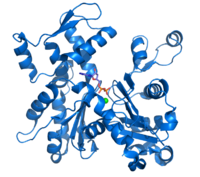
Photo from wikipedia
Making the right catch Tension reveals cryptic vinculin-binding sites on α-catenin and talin at cadherin-based cell-cell and integrin-based cell-matrix adhesions, respectively. The enrichment of vinculin at cellular adhesions is thus… Click to show full abstract
Making the right catch Tension reveals cryptic vinculin-binding sites on α-catenin and talin at cadherin-based cell-cell and integrin-based cell-matrix adhesions, respectively. The enrichment of vinculin at cellular adhesions is thus an indicator of load-induced reinforcement of the cytoskeletal linkage. Huang et al. used a single-molecule optical trap assay to measure the binding lifetimes of vinculin to single actin filaments under load. The vinculin-F-actin interaction formed a directional catch bond—one that is very weak at low force but that greatly increases in lifetime with increasing force. This explains vinculin's role as a reinforcing linker at both cell-cell and cell-matrix adhesions. Science, this issue p. 703 The cell adhesion protein vinculin forms a load- and direction-dependent bond with actin filaments. Vinculin is an actin-binding protein thought to reinforce cell-cell and cell-matrix adhesions. However, how mechanical load affects the vinculin–F-actin bond is unclear. Using a single-molecule optical trap assay, we found that vinculin forms a force-dependent catch bond with F-actin through its tail domain, but with lifetimes that depend strongly on the direction of the applied force. Force toward the pointed (–) end of the actin filament resulted in a bond that was maximally stable at 8 piconewtons, with a mean lifetime (12 seconds) 10 times as long as the mean lifetime when force was applied toward the barbed (+) end. A computational model of lamellipodial actin dynamics suggests that the directionality of the vinculin–F-actin bond could establish long-range order in the actin cytoskeleton. The directional and force-stabilized binding of vinculin to F-actin may be a mechanism by which adhesion complexes maintain front-rear asymmetry in migrating cells.